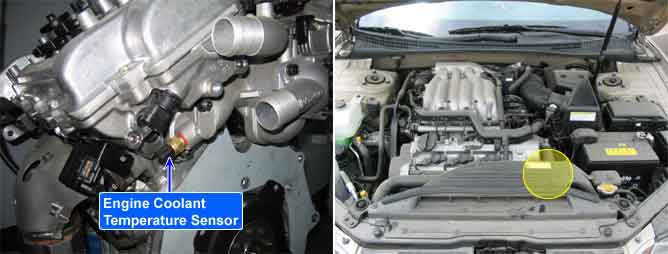

The Engine Coolant Temperature Sensor (ECTS) is located in the engine coolant passage of the cylinder head for detecting the engine coolant temperature. The ECTS uses a thermistor whose resistance changes with the temperature. The electrical resistance of the ECTS decreases as the temperature increases, and increases as the temperature decreases. The reference 5 V in the ECM is supplied to the ECTS via a resistor in the ECM. That is, the resistor in the ECM and the thermistor in the ECTS are connected in series. When the resistance value of the thermistor in the ECTS changes according to the engine coolant temperature, the output voltage also changes. During cold engine operation the ECM increases the fuel injection duration and controls the ignition timing using the information of engine coolant temperature to avoid engine stalling and improve drivability.
Checking output signals from ECTS under detecting condition, if an output signal is intermittently above 4.9V, PCM sets P1115.
Item | Detecting Condition | Possible Cause |
DTC Strategy | ● Monitor the signal of ECTS | ● Poor Connection ● Open or short to battery in signal circuit ● Open in ground circuit ● Faulty ECTS ● Faulty PCM |
Enable Conditions | Case 1 | ● Time after start-up > 120 sec. |
Case 2 | ● Time from IG "OFF" to IG "ON" > 360 min. ● Intake air temperature ≥ -10℃(14℉) ● Engine running state | |
Threshold value | ● Intermittently engine coolant temperature sensor’s voltage > 4.9V | |
Diagnosis Time | ● Continuous | |
MIL On Condition | ● DTC only(NO MIL ON) |
Temp. (°C/°F) | Resistance (kΩ) | Temp. (°C/°F) | Resistance (kΩ) |
-40(-40) | 48.14 | 40(104) | 1.15 |
-20(-4) | 14.13 ~ 16.83 | 60(140) | 0.59 |
0(32) | 5.79 | 80(176) | 0.32 |
20(68) | 2.31 ~ 2.59 |
